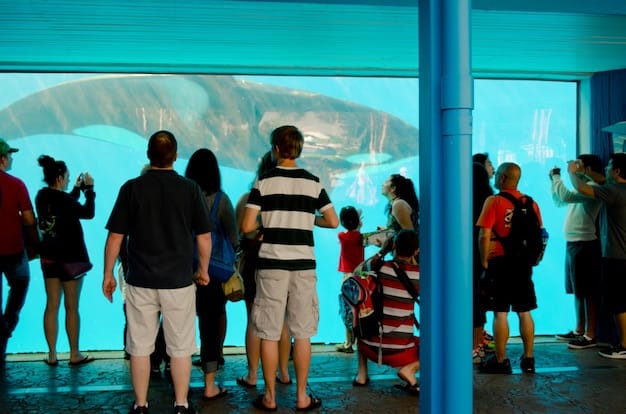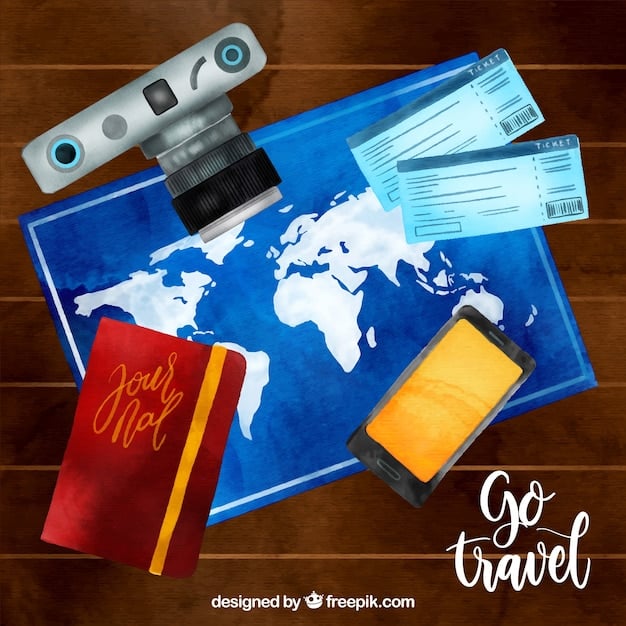US Visa Requirements 2025: What Travelers Need to Know

The United States is continually evaluating its immigration policies, and while no official statements confirm new general visa requirements for 2025, travelers should stay informed about potential changes to existing programs like the ESTA and specific visa categories, which could impact entry procedures and eligibility.
As 2025 approaches, many international travelers are asking: Is the US Considering New Visa Requirements for 2025? What Travelers Need to Know Now. The dynamic landscape of global travel and security often leads to speculation about changes in entry policies. Understanding the current situation and how to prepare is crucial for anyone planning a visit to the United States.
Understanding the Current US Visa Landscape
Before delving into potential future changes, it’s essential to grasp the existing framework of US visa and entry requirements. The United States employs a multi-tiered system designed to facilitate legitimate travel while maintaining national security. This system includes various visa categories for different purposes—tourism, business, study, work, and more—each with specific eligibility criteria and application processes.
Alongside traditional visas, the Visa Waiver Program (VWP) allows citizens of certain countries to travel to the US for tourism or business for stays of 90 days or less without obtaining a visa. Travelers under the VWP must secure an approved Electronic System for Travel Authorization (ESTA) prior to their departure. This dual approach ensures both flexibility for eligible travelers and a layer of pre-screening for security purposes.
Key Visa Categories and Their Purposes
The US Department of State outlines a comprehensive list of nonimmigrant visas, each tailored to specific travel intentions. Understanding these categories is the first step for any prospective traveler.
- B-1 Visas: Issued for temporary business travel, including consulting with business associates, attending scientific, educational, professional, or business conventions/conferences, settling an estate, or negotiating contracts.
- B-2 Visas: Designated for tourism, vacation, visiting friends or relatives, medical treatment, participation in social events hosted by fraternal, social, or service organizations, and participation as an amateur in musical, sports, or similar events or contests, if not compensated.
- F-1 Visas: For academic students attending universities or other academic institutions.
- J-1 Visas: Issued for exchange visitors participating in programs approved by the U.S. Department of State, designed to promote the interchange of persons, knowledge, and skills.
Each visa type has its own application form, required documentation, interview process, and associated fees. The application typically starts with the DS-160 form, followed by an interview at a US embassy or consulate in the applicant’s home country. The process can be time-consuming, emphasizing the need for early planning and meticulous preparation.
The Visa Waiver Program, on the other hand, streamlines entry for citizens of 40 participating countries. While it bypasses the need for a traditional visa, an approved ESTA is mandatory. This electronic authorization often takes only minutes to process, though it can take up to 72 hours, and is valid for two years or until the passport expires, whichever comes first. It’s crucial not to confuse ESTA with a visa; it’s an authorization to travel under the VWP.
Evaluating the Speculation: Why New Requirements Might Emerge
Speculation surrounding new US visa requirements is not uncommon. Several factors continually fuel these discussions, ranging from evolving national security threats to global health concerns and shifts in geopolitical landscapes. Understanding these underlying drivers can provide context to any rumors or official announcements.
National security remains a paramount concern for any sovereign nation. Events globally, whether related to terrorism, cyber warfare, or other geopolitical tensions, often trigger reviews of border security protocols. This can sometimes lead to discussions about tightening entry requirements, enhancing screening procedures, or adjusting eligibility for existing programs.
Factors Influencing Policy Decisions
Policy changes are rarely arbitrary. They are typically the result of a confluence of internal and external pressures, evaluated by various government agencies.
- National Security Concerns: Heightened threat assessments often lead to calls for more stringent vetting processes for all international arrivals.
- Public Health Crises: Global pandemics, as seen recently, can dramatically alter travel policies, including requirements for vaccinations, testing, or enhanced health screenings.
- Economic and Diplomatic Relations: Bilateral agreements and international relations play a significant role. A strained relationship with one country might lead to different visa policies than with a close ally.
- Technological Advancements: Improved data analytics and biometric technologies can enable more sophisticated screening, potentially leading to new requirements for data submission or biometric collection.
The current administration’s stance on immigration, border security, and international travel also heavily influences policy directions. Each administration may prioritize different aspects, leading to shifts in existing rules or the introduction of entirely new ones. For instance, some administrations may focus on streamlining travel for specific groups, while others may emphasize more restrictive measures across the board.
The legislative process for implementing new visa requirements is complex and often lengthy. Any major systemic change would typically require Congressional approval or significant policy shifts within relevant departments like the Department of State or Homeland Security. This often provides ample opportunity for public discourse and expert analysis before any new rule takes effect.

Decoding Official Statements and Rumors
In the digital age, deciphering official information from mere rumors can be challenging, especially concerning sensitive topics like international travel regulations. For travelers, relying on credible sources is not just advisable; it’s essential. Official announcements regarding US visa changes typically originate from specific government bodies, ensuring accuracy and authority.
The primary sources for official information are the U.S. Department of State and the U.S. Department of Homeland Security (DHS). These departments are responsible for managing foreign policy and national security, respectively, making them the authoritative voices on visa and entry requirements. Their official websites, press releases, and embassy communications are the most reliable channels for updates.
Where to Find Reliable Information
Knowing where to look saves time and prevents misinformation, which can have serious implications for travel plans.
- U.S. Department of State Website: The Consular Affairs section provides comprehensive details on all visa types, application processes, and current regulations.
- U.S. Citizenship and Immigration Services (USCIS): While more focused on immigration, USCIS also provides information relevant to long-term stays and some visa categories.
- U.S. Customs and Border Protection (CBP): CBP handles entry and exit procedures and offers guidelines for travelers entering the US, including ESTA information.
- Official Embassy and Consulate Websites: Each US embassy and consulate abroad maintains a website with country-specific information, local updates, and application instructions.
Travel advisories issued by these bodies often contain critical information about changes in entry policies, health restrictions, or security warnings. It’s crucial for travelers to regularly check these resources, especially in the months leading up to their planned travel date. Subscribing to official newsletters or following their social media accounts can also help in receiving timely alerts.
Regarding “new visa requirements for 2025,” it’s important to note that as of now, no concrete, widespread changes have been officially announced for 2025 that would significantly alter the general mechanisms of US visa applications or the Visa Waiver Program. Most discussions tend to center around enhanced screening, biometric data collection, or minor adjustments to existing programs rather than a complete overhaul of the visa system. Any significant change would likely involve a lengthy public comment period and ample notification, given the widespread impact it would have on international travel and tourism.
Potential Areas for Policy Adjustments in 2025
While definitive new visa requirements for 2025 have not been announced, several areas within the existing framework are continually evaluated and could see adjustments. These potential changes often aim to enhance security, streamline processes, or adapt to evolving global circumstances. Understanding these areas allows travelers to anticipate possible shifts.
One primary area of continuous review is the Visa Waiver Program itself. Although highly successful in facilitating travel, there are ongoing discussions about its security features and potential enhancements. This could include more rigorous background checks for ESTA applicants, increased data sharing agreements with VWP countries, or even minor adjustments to eligibility criteria based on geopolitical developments. These wouldn’t necessarily be “new visa requirements” but rather an evolution of the existing waiver program.
Enhanced Security Screening
The drive for improved security is constant, and technology often plays a key role in these advancements.
- Biometric Data Collection: Expansion of biometric data collection (e.g., facial recognition, fingerprint scans) upon entry or during the visa application process could become more widespread.
- Advanced Passenger Information: More detailed data might be requested from airlines and cruise lines about passengers prior to their arrival.
- Social Media Vetting: While already in use for some visa applicants, increased scrutiny of public social media profiles could expand to a broader range of travelers.
- Health-related screenings: Depending on global health trends, specific health declarations or proof of vaccinations might become standardized requirements, beyond what was seen during the COVID-19 pandemic.
Another area for potential policy adjustments relates to visa interview processes. While in-person interviews remain a cornerstone for many visa categories, there might be discussions around utilizing remote technologies for certain situations, or conversely, making interview waivers more restrictive. The efficiency and security of these appointments are under constant review to balance accessibility with vetting demands.
The digital transformation of government services also presents opportunities for change. The US government is always looking for ways to digitize forms, improve online application portals, and enhance the overall user experience while maintaining the integrity and security of the systems. This could mean more user-friendly interfaces, but also potentially more detailed data input requirements for applicants.
Preparing for Your Trip: Essential Steps for Travelers
Regardless of whether new visa requirements are implemented, thorough preparation is always the traveler’s best strategy. Proactive steps can mitigate stress and potential delays, ensuring a smoother journey to the United States. This preparation begins well in advance of departure, ideally months before.
The first and most critical step is to identify your appropriate travel document. For many, this means a valid passport. Ensure your passport is current and, crucially, valid for at least six months beyond your intended period of stay in the US. Some countries have agreements that waive this six-month rule, but it’s always safer to have a passport with ample validity. Renewing a passport can take weeks or even months, so check its expiration date well in advance.
Checklist for Proactive Travelers
A structured approach to travel preparation can help cover all bases.
- Verify Passport Validity: Ensure your passport is valid for at least six months beyond your planned departure from the US.
- Determine Entry Requirements: Ascertain if you need a visa or if you qualify for the Visa Waiver Program (ESTA). Apply well in advance for either, as processing times can vary.
- Gather Supporting Documentation: Collect proof of onward travel, accommodation bookings, financial solvency, and ties to your home country (job letter, property deeds) as these may be requested by immigration officials.
- Understand Customs Regulations: Familiarize yourself with what items are permitted and prohibited to bring into the US to avoid issues at customs.
If a visa is required, initiate the application process early. This includes completing the DS-160 form accurately, scheduling an interview at the nearest US embassy or consulate, and gathering all necessary supporting documents. Visa interview wait times can be extensive, particularly in high-demand locations, so planning ahead is not merely a suggestion but a necessity.
For those eligible for the Visa Waiver Program, the ESTA application should also be completed well before travel. While often approved quickly, there are instances where applications may take up to 72 hours, or even be denied, requiring a subsequent visa application. Don’t wait until the last minute to apply for your ESTA; aim to complete it weeks before your trip.
Beyond official documents, travelers should also consider travel insurance. While not a formal entry requirement, travel insurance can provide crucial financial protection against unforeseen events such as medical emergencies, trip cancellations, or lost luggage, enhancing peace of mind during your visit.
Impact on Different Traveler Groups
Potential changes to US visa requirements or entry policies can have varied impacts depending on a traveler’s nationality, purpose of visit, and previous travel history. Not all groups are affected equally, and understanding these nuances is key for appropriate planning. For instance, citizens of Visa Waiver Program (VWP) countries might experience different adjustments compared to those who always require a traditional visa.
Travelers from VWP countries, while enjoying expedited entry under ESTA, might face increased scrutiny in their ESTA applications or enhanced screening procedures upon arrival. Any changes to the VWP eligibility criteria, though rare, would have a significant impact, potentially necessitating a full visa application for citizens who previously only needed an ESTA. This could lead to longer processing times and additional costs for these travelers.
Who Might Be Most Affected?
Certain groups could feel the ripples of policy shifts more profoundly than others.
- First-time Travelers: Those with no prior US travel history may undergo more extensive vetting processes.
- Travelers from Non-VWP Countries: Any enhancement in visa application background checks or interview protocols would directly affect this group due to their existing requirement for traditional visas.
- Individuals with Complex Travel Histories: Travelers who have previously overstayed a visa, been denied entry, or visited countries deemed high-risk might face additional questions or delays.
- Business and Student Travelers: These groups often require specific visa types (e.g., B-1, F-1, J-1) and could be subject to new rules regarding documentation, proof of funds, or program eligibility.
Business travelers, whose schedules are often tight and dependent on predictable travel conditions, would need to be particularly vigilant. Delays in visa processing or new documentation demands could directly impact business operations and international collaborations. Companies often provide support for their employees’ visa applications, but even with assistance, new complexities can arise.
Students also represent a significant group of international travelers to the US. Any changes in F-1 or J-1 visa regulations, or even tighter scrutiny during the application process, could affect their ability to pursue education or participate in exchange programs. Universities and educational institutions typically stay informed of such changes and advise their international students accordingly, making their resources invaluable.
Ultimately, all travelers are encouraged to personally verify the latest requirements that apply to their specific situation, rather than relying solely on general information. Consulting the official government websites for their country of citizenship and the US Department of State remains the most reliable method to ensure compliance and avoid any unwelcome surprises at the border.
Future Outlook: Continuous Evolution of Travel Policies
The landscape of international travel policies is not static; it is a continuously evolving domain shaped by global events, technological advancements, and shifting national priorities. Looking ahead to 2025 and beyond, it’s safe to assume that US visa and entry requirements will continue to adapt. This evolution is driven by the dual imperatives of facilitating legitimate travel and safeguarding national security, a balance that constantly requires adjustment.
One prominent trend is the increasing reliance on technology for border security and traveler vetting. Biometric screening, advanced data analytics, and artificial intelligence are becoming integral tools in identifying potential risks and streamlining entry processes for low-risk travelers. This could lead to more sophisticated pre-screening methods, potentially making entry smoother for those who meet the criteria, while increasing scrutiny for others.
Key Trends Shaping Future Travel Policies
Several overarching themes are likely to guide policy development in the coming years, impacting how travelers interact with US entry requirements.
- Digitalization and Automation: Expect more online processes, digital forms, and potentially even AI-assisted application reviews to enhance efficiency.
- Data-Driven Security: Increased collection and analysis of traveler data to identify patterns and potential threats before arrival.
- Global Health Integration: Permanent integration of health-related documentation (e.g., vaccination records, health declarations) into standard travel protocols, especially in the wake of recent pandemics.
- Interagency Cooperation: Enhanced collaboration between US governmental agencies and international partners to share information and coordinate security efforts.
The emphasis on global health is likely to persist. While the immediate crisis of COVID-19 has subsided, the experience highlighted the vulnerability of international travel to widespread health concerns. Future policies may incorporate more robust frameworks for responding to public health threats, which could include mandatory health declarations, proof of certain vaccinations, or even health checks at points of entry, depending on global circumstances.
Moreover, the concept of “trusted traveler programs” could see further expansion. Programs like Global Entry, which offer expedited customs processing for pre-approved, low-risk travelers, demonstrate a model where enhanced vetting upfront leads to a more seamless experience at the border. While not directly “visa requirements,” their growth could influence the broader approach to international arrivals, favoring those who opt into and qualify for such programs.
For travelers, the overarching message remains one of adaptability and vigilance. Regularly consulting official government sources and being prepared for potential changes, even minor ones, will be key to navigating future travel to the United States successfully. The intent is not to deter travel, but to ensure it is as secure and efficient as possible for everyone involved.
| Key Point | Brief Description |
|---|---|
| ✈️ Current Status | No official announcements for new general visa requirements for 2025. Existing visa categories and ESTA remain in effect. |
| 🔍 Policy Drivers | National security, public health trends, economic relations, and technological advancements continuously influence policy reviews. |
| ✅ Reliable Sources | US Department of State, USCIS, CBP, and official embassy websites are primary sources for accurate information. |
| 🛂 Traveler Prep | Verify passport validity, determine entry requirements (visa/ESTA), gather documents, and understand customs well in advance. |
Frequently Asked Questions About US Visa Requirements
As of now, there are no official announcements confirming entirely new general visa requirements for the United States in 2025. The existing system, including various visa categories and the Visa Waiver Program (ESTA), remains in effect. Travelers should always consult official US government sources for the most up-to-date information before making travel plans.
To determine if you need a visa or if you’re eligible for an ESTA, you should visit the official U.S. Department of State website or the U.S. Customs and Border Protection website. Your nationality, purpose of travel, and length of stay are key factors. Citizens of Visa Waiver Program countries can apply for an ESTA; others typically require a specific visa type.
The Visa Waiver Program allows citizens of 40 participating countries to travel to the United States for tourism or business for stays of 90 days or less without a visa. The Electronic System for Travel Authorization (ESTA) is a mandatory online application for pre-screening travelers under the VWP. An approved ESTA is required before boarding a flight or ship to the US.
The most reliable sources for updates on US travel policies are the official websites of the U.S. Department of State (travel.state.gov), U.S. Citizenship and Immigration Services (USCIS.gov), and U.S. Customs and Border Protection (CBP.gov). Additionally, refer to the official website of the US embassy or consulate in your home country for country-specific information.
It is strongly recommended to apply for a US visa or ESTA as far in advance as possible. Visa application processing times can vary significantly, often taking several weeks or even months due to interview wait times and administrative processing. ESTA applications usually process quickly, but can take up to 72 hours, so applying at least 72 hours before travel is the minimum, though earlier is always better.
Conclusion
While the prospect of new US visa requirements for 2025 frequently arises in travel discussions, it’s critical for travelers to distinguish between speculation and official policy. As of the current moment, no sweeping new requirements have been formally announced. The United States continues to operate under its comprehensive visa system and the Visa Waiver Program, with ongoing, routine evaluations and minor adjustments always possible. Proactive preparation, meticulous research through official government channels, and understanding existing regulations remain the most effective strategies for any international traveler planning a visit to the US. Staying informed through credible sources ensures a smooth and complaint travel experience, allowing visitors to focus on their journey rather than navigating unexpected bureaucratic hurdles. The global travel landscape is dynamic, but a well-prepared traveler will always be able to adapt to its evolutions.





